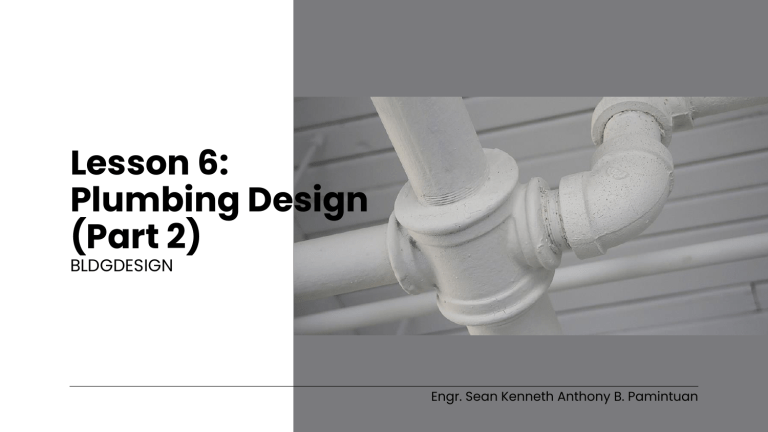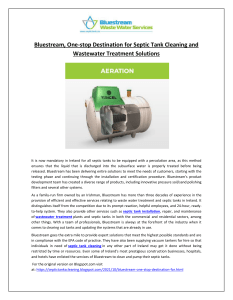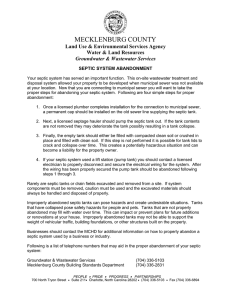
Lesson 6: Plumbing Design (Part 2) BLDGDESIGN Engr. Sean Kenneth Anthony B. Pamintuan DRAINAGE, WASTE, and VENTS (DWV) Fixture Unit – is an arbitrary quantity in terms of which the load-producing effects or water requirements on the plumbing system of different kinds of plumbing fixtures are expressed in some arbitrarily chosen scale. One fixture unit is equivalent to a rate of flow at 28.3 liters per minute (1 cu.ft./minute). Fajardo, Jr., M. Plumbing Design and Estimate 2nd Edition. (2001) DRAINAGE, WASTE, and VENTS (DWV) PROBLEM 1 Determine the size of a horizontal waste pipe sloped at 2% to serve 6 urinals, 3 lavatories, 8 showers, and 2 slop sinks. Use RNPCP Table 7-2 and 7-5. Subtotal F.U. Fixture Qty F.U. (Qty x F.U.) Urinal 6 3 18 Lavatory 3 1 3 Shower 8 2 16 Slop Sink 2 3 6 Total F.U. = 43 sink, service Assumed wall-mounted with integral trap. PROBLEM 1 Determine the size of a horizontal waste pipe sloped at 2% to serve 6 urinals, 3 lavatories, 8 showers, and 2 slop sinks. Use RNPCP Table 7-2 and 7-5. Total F.U. = 43 Use 102 mm⌀ horizontal pipe THE SEPTIC TANK Septic Tank – a water-tight receptacle which receives the discharge of a sanitary plumbing system or part thereof, designed and constructed to retain solids, digest organic matter through a period of detention and to allow the liquids to discharge into the soil outside of the tank through a system of open-jointed subsurface pipings or a seepage pit meeting the requirements of this Code. https://www.netsolwater.com/solutions-to-septic-tank-problems.php?blog=1578 FUNCTIONS OF THE SEPTIC TANK 1. Biological Treatment – Sewage effluent (fecal matter) is subjected to decomposition by natural, bacterial processes. The bacteria present in the liquid are anaerobic (i.e. they thrive in the absence of free oxygen). This decomposition, or treatment, of the sewage under anaerobic conditions is termed “septic”, hence the name of the tank. 2. Solids Removal Sludge – is defined as an accumulation of solids that settled at the bottom of the septic tank. Scum – is a partially submerged mat of floating solids that forms at the surface of the fluid in the septic tank. Some sludge and scum are decomposed. The residual material, composed of inert solid material, remains. After a period of time, these solids including all types of grease, must be pumped out. Space must be provided in the septic tank to store this residue between cleanings; otherwise, sludge and scum eventually will be scoured from the septic tank and may clog the disposal field. https://www.netsolwater.com/solutions-to-septic-tank-problems.php?blog=1578 SEPTIC TANK LOCATION SEPTIC TANK CONSTRUCTION https://www.netsolwater.com/solutions-to-septic-tank-problems.php?blog=1578 CAPACITY OF SEPTIC TANK - RNPCP PROBLEM 2 Determine the minimum length of a septic tank to serve 6 urinals, 3 lavatories, 8 showers, and 2 slop sinks. The septic tank is limited to a width of 1.00 m and a depth of 1.50 m. Use RNPCP Table 7-2 for the Fixture Units and Table B-2 for the capacity of Septic Tanks. Solution: Total F.U. = 43 (from item no. 1) Based from RNPCP B5.4, • Min. Width = 0.9 m • Min. Length = 1.5 m • Liquid Depth Range = 0.6 m to 1.8 m (24” to 72”) Minimum ST Capacity = 7570 liters ∙ Minimum ST Capacity = 7.57 m3 L x W x D = 7.57 m3 L (1.00 m) (1.50 m) = 7.57 m3 L = 5.0467 m, say 5.1 m 1 m3 1,000 liters REFERENCES Fajardo, Jr., M. Plumbing Design and Estimate 2nd Edition. (2001)





